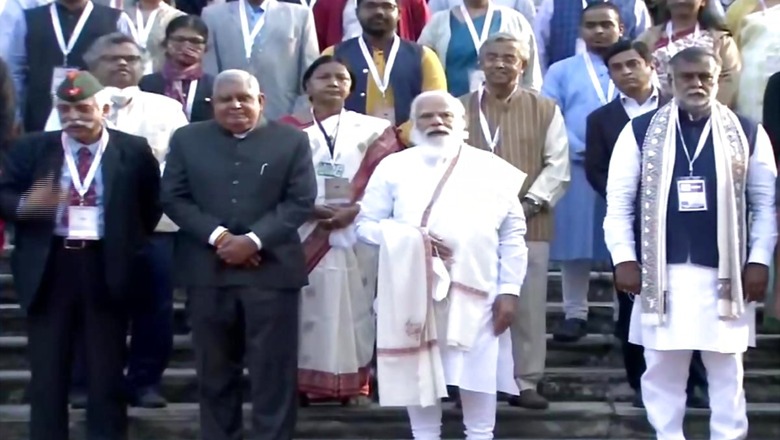
views
The poll pot is about to reach boiling point and, among all the states where elections are to be held, West Bengal is generating the most heat. Prime Minister Narendra Modi remains the biggest star campaigner and vote-catcher for the Bharatiya Janata Party, and his appearance has provoked much curiosity and conjecture in the past few months. His long hair and flowing beard have led to comparisons with Rabindranath Tagore. Party leaders have pointed out that universalism and self-reliance are among the poet’s views that Modi has connected to his policies and politics, even as the state’s ruling Trinamool Congress has been trying to paint him and the BJP as “outsiders”.
But this is not the only connection the PM has with Bengal. Modi came to Delhi as Prime Minister in 2014. However, his first visit to Tagore’s land happened long back. At the age of 17, when he left home to tour across the country, one of the first few places he visited was the Ramakrishna Mission at Kolkata’s Belur Math. In fact, he wanted to become a monk but faced rejection three times. Swami Madhavanandaji, the-then president of RKM, turned Modi away. He finally met Swami Atmasthanandaji Maharaj, who was the Mission head in Rajkot in 1996. Swamiji had a huge influence on Modi’s life by bringing to him the teachings of Swami Vivekananda.
In fact, after becoming the Prime Minister in 2014, Modi’s first visit to Bengal in May 2015 saw him go to the Belur Math and Dakshineswar Kali Temple and meet an ailing Swami Atmasthanandji Maharaj in hospital.
From coining terms like “Ashol Poriborton” which translates to “real change” to counter the TMC slogan “Khela Hobe” (game on), to his own style of saying “Khela Shesh, Vikas Shuru” (game ends, development begins), the PM has often received thunderous responses from crowds at rallies in poll-bound Bengal.
When speaking on Bengal, Modi has often been mentioning mystic Ramakrishna Paramahansa, mathematician Radhanath Sikdar, philosopher Bhudeb Mukhopadhyay, novelist Bankim Chandra Chattopadhyay, Independence icon Netaji Subhas Chandra Bose, and Nobel Prize-winning poet Tagore, all proud sons of Bengal’s soil.
Those who’ve followed the journey of Narendra Modi will agree that he has the art of picking up local languages and speaking them even if it’s just a couple of sentences or even a few words.
On the occasion of Mahashashti last year, the PM had virtually inaugurated a Durga Puja programme organised by the BJP’s mahila morcha and its cultural wing in Kolkata. He began his speech in Bangla by saying, “Prothome aapnader shokolke janayi Shree Shree Durga Pujor, Kali Pujor priti o subhechha. Banglar ei pobitro bhumi te Durga Pujor shomoy aapnader shokoler moddhe aashte pere aaj aami nije ke dhonno maanchi (I extend my greetings for Durga Puja, Kali Puja and I feel very lucky to be with you on the holy land of Bengal on this occasion).”
Even when speaking at the Victoria Memorial on the January 23 Parakram Diwas celebrations this year to mark the 125th birth anniversary of Netaji Subhas Chandra Bose, Modi spoke quite a few lines.
At the 2019 ‘Howdy, Modi!’ mega event in Houston, the PM had said, “When you have asked ‘Howdy, Modi!’, then my heart says the answer to that really is, ‘All is well in India’.”
He added, “Bharat me sab achha hai … Sab changa si … Saba maja mache … Anta baagundi … Ella chenaagide … Yellam soukhyam …Sarva chhanchalale aahe… Sab khub bhalo… Saboo bhalaachhi,” in Hindi, Punjabi, Gujarati, Telugu, Kannada, Tamil, Marathi, Bengali, Odia, etc.
In fact, whenever he is visiting a state, he uses the local languages to get local connections.
On October 31, 2020, while speaking at the National Unity Day celebrations marking the birth anniversary of Sardar Vallabhbhai Patel in Kevadia, PM Modi had quoted a poem in Tamil by legendary poet Subramania Bharati, which speaks of India being a “golden country”.
While addressing the closing ceremony of the centenary celebrations of the Shri Jagadguru Vishwaradhya Gurukul in Varanasi in February last year, the PM received widespread applause as he spoke in four different languages, Kannada, Telugu, Marathi, and Hindi, on the occasion.
Prime Minister Narendra Modi in fact is often seen exchanging tweets with world leaders in their local languages and a similar response comes from them in Indian languages. From the Japanese PM to the Australian Prime Minister to the Israeli government, Modi’s personal touch with everyone is unmissable and the connection quite personalised.
Read all the Latest News, Breaking News and Coronavirus News here
















Comments
0 comment